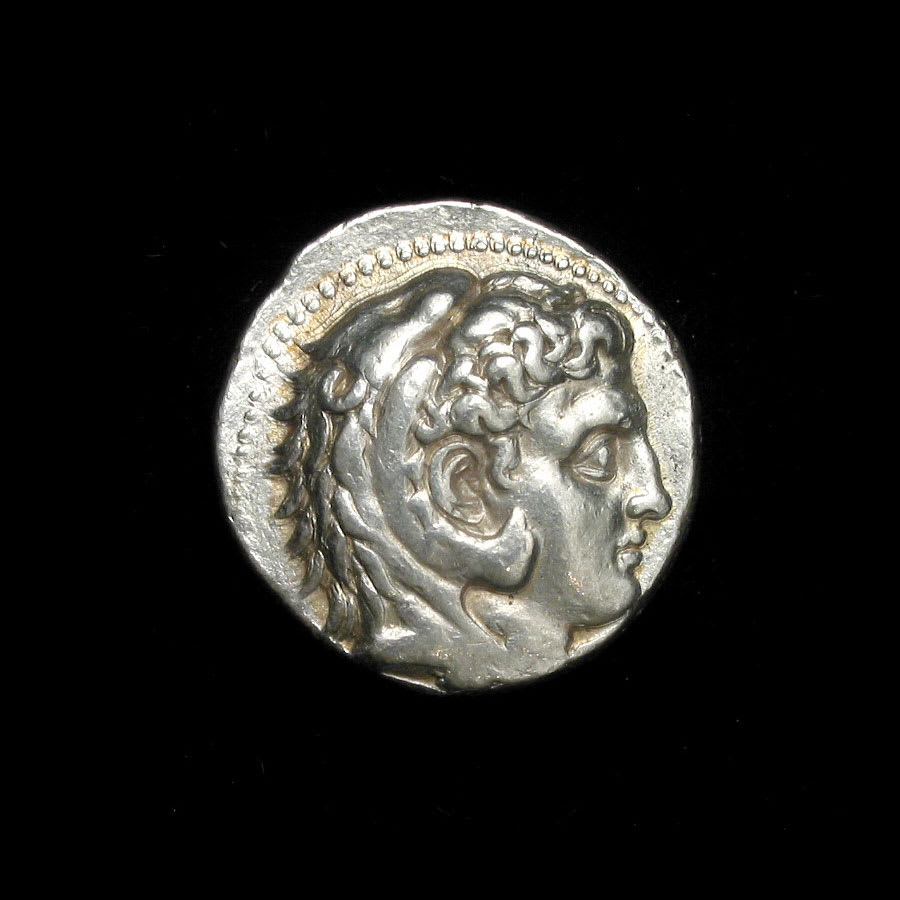Silver Tetradrachm of King Philip III Arrhidaeus, 323 BCE - 317 BCE
Silver
C.6453
Obverse: The Head of Herakles Wearing the Skin of the Nimean Lio Reverse: Zeus Enthroned Facing Left Holding an Eagle and a Scepte Historically, Arrhidaeus, bastard child of King Philip...
Obverse: The Head of Herakles Wearing the Skin of the Nimean Lio
Reverse: Zeus Enthroned Facing Left Holding an Eagle and a Scepte
Historically, Arrhidaeus, bastard child of King Philip II, is best known as one of the half-brothers of Alexander the Great. Yet while his brother rose to glory, carving out one of the largest empires the world has ever known, Arrhidaeus has vanished into obscurity. Ancient texts convey the fact that Arrhiaeus was mentally impaired. Although this might have been due to natural causes, effective from birth, some contrary rumors were circulated. Legend has it that Olympias, the mother of Alexander, attempted to poison Arrhidaeus so that her child would be first in line for the throne. This would both be in keeping with her malicious, meddling character and explain any mental disorders. Regardless of this story’s credibility, there are many other tales where Olympias manipulated Alexander to act out against his brother. Needless to say, these instances often were more beneficial to Olympias herself than her son. However, upon the death of Alexander the Great, Arrhidaeus was proclaimed king and assumed the title of Philip III. Although he ruled for six year (323-317 B.C.) until his death, he was king in little more than name.
How many hands have touched a coin in your pocket or your purse? What eras and lands have the coin traversed on its journey into our possession? As we reach into our pockets to pull out some change, we rarely hesitate to think of who touched the coin before us, or where the coin will venture to after us. More than money, coins are a symbol of the state that struck them, of a specific time and place, whether currency in the age we live or an artifact of a long forgotten empire. This stunning hand-struck coin reveals an expertise of craftsmanship and intricate sculptural detail that is often lacking in contemporary machine-made currencies. Although the empire of Alexander soon dissolved after his death due to internal struggles and inept leadership, his successors adopted much of his iconography, demonstrated by this coin, in order to legitimize their claims to power. This coin is an ancient memorial to a forgotten king passed down from the hands of generation to generation, from civilization to civilization.
Reverse: Zeus Enthroned Facing Left Holding an Eagle and a Scepte
Historically, Arrhidaeus, bastard child of King Philip II, is best known as one of the half-brothers of Alexander the Great. Yet while his brother rose to glory, carving out one of the largest empires the world has ever known, Arrhidaeus has vanished into obscurity. Ancient texts convey the fact that Arrhiaeus was mentally impaired. Although this might have been due to natural causes, effective from birth, some contrary rumors were circulated. Legend has it that Olympias, the mother of Alexander, attempted to poison Arrhidaeus so that her child would be first in line for the throne. This would both be in keeping with her malicious, meddling character and explain any mental disorders. Regardless of this story’s credibility, there are many other tales where Olympias manipulated Alexander to act out against his brother. Needless to say, these instances often were more beneficial to Olympias herself than her son. However, upon the death of Alexander the Great, Arrhidaeus was proclaimed king and assumed the title of Philip III. Although he ruled for six year (323-317 B.C.) until his death, he was king in little more than name.
How many hands have touched a coin in your pocket or your purse? What eras and lands have the coin traversed on its journey into our possession? As we reach into our pockets to pull out some change, we rarely hesitate to think of who touched the coin before us, or where the coin will venture to after us. More than money, coins are a symbol of the state that struck them, of a specific time and place, whether currency in the age we live or an artifact of a long forgotten empire. This stunning hand-struck coin reveals an expertise of craftsmanship and intricate sculptural detail that is often lacking in contemporary machine-made currencies. Although the empire of Alexander soon dissolved after his death due to internal struggles and inept leadership, his successors adopted much of his iconography, demonstrated by this coin, in order to legitimize their claims to power. This coin is an ancient memorial to a forgotten king passed down from the hands of generation to generation, from civilization to civilization.



